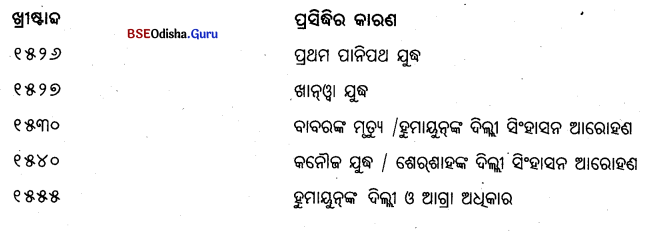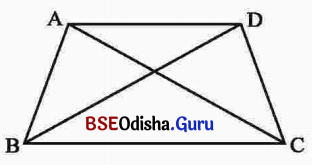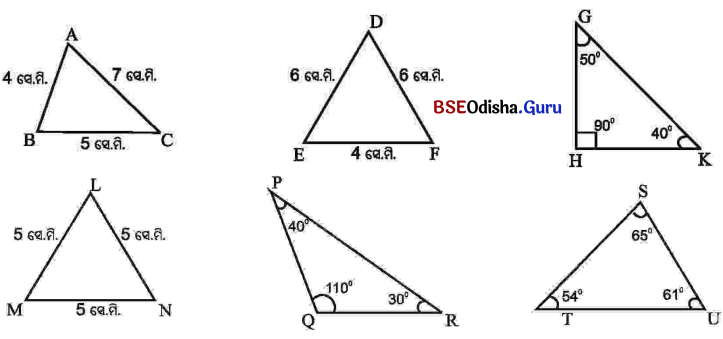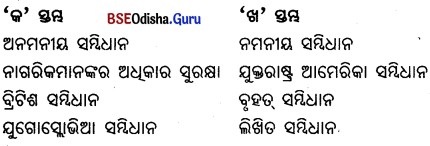Odisha State Board BSE Odisha 7th Class History Important Questions Chapter 3 ମୋଗଲ ସାମ୍ରାଜ୍ୟ (୧୫୨୬ – ୧୭୦୭) Important Questions and Answers.
BSE Odisha Class 7 History Important Questions Chapter 3 ମୋଗଲ ସାମ୍ରାଜ୍ୟ (୧୫୨୬ – ୧୭୦୭)
Subjective Type Questions With Answers
ଦୀର୍ଘ ଉତ୍ତରମୂଳକ ପ୍ରଶ୍ନୋତ୍ତର
୧। ବାବରଙ୍କର କୃତିତ୍ୱ ବର୍ଣନା କର ।
Answer:
- ବାବର ତୈମୁରଲଙ୍ଗଙ୍କ ବଂଶଧର ଥିଲେ । ତାଙ୍କ ପିତାଙ୍କ ନାମ ଥିଲା ଉମର୍ ଶେଖ୍ ମିର୍ଜା । ସେ ତୁର୍କୀସ୍ଥାନ ଅନ୍ତର୍ଗତ ଫରଗଣାର ରାଜା ଥିଲେ । ସେ ଜଣେ ସାହସୀ ବୀର ଥିଲେ ଓ ସୈନ୍ୟଚାଳନାରେ ତାଙ୍କର ବିଶେଷ ଦକ୍ଷତା ଥିଲା ।
- ସେ କାବୁଲ ଓ କାନ୍ଦାହାର ଜୟ କରିବା ପରେ ୧୫୨୬ ଖ୍ରୀଷ୍ଟାବ୍ଦରେ ପାନିପଥ ନାମକ ସ୍ଥାନରେ ଦିଲ୍ଲୀ ସମ୍ରାଟ ଇବ୍ରାହିମ୍ ଲୋଦୀଙ୍କୁ ପରାସ୍ତ କରି ଭାରତରେ ବିଶାଳ ମୋଗଲ ସାମ୍ରାଜ୍ୟର ମୂଳଭିତ୍ତି ସ୍ଥାପନ କରିଥିଲେ ।
- ସେ ୧୫୨୭ ଖ୍ରୀ.ଅ.ରେ ରାଣାସଙ୍ଗଙ୍କୁ ଖାନୱାଠାରେ ପରାସ୍ତ କରିବା ସହ ୧୫୨୮ ଖ୍ରୀ.ଅ.ରେ ଚନ୍ଦିରୀ ଦୁର୍ଗ ଅତ୍କାର କରିଥିଲେ ।
- ୧୫୨୯ ଖ୍ରୀ.ଅ.ରେ ନୁସ୍ରତ୍ ଓ ମାହମୁଦ୍ଙ୍କୁ ପାଟନା ନିକଟବର୍ତୀ ଘର୍ଘରା ନଦୀ କୂଳରେ ସେ ପରାସ୍ତ କରିଥିଲେ । ଏହି ଯୁଦ୍ଧ ଥୁଲା ତାଙ୍କ ଜୀବନର ଶେଷ ଯୁଦ୍ଧ ।
- ବାବର ୧୫୩୦ ଖ୍ରୀଷ୍ଟାବ୍ଦରେ ମୃତ୍ୟୁବରଣ କରିଥିଲେ । ତାଙ୍କର ମୃତ୍ୟୁବେଳକୁ ତାଙ୍କ ସାମ୍ରାଜ୍ୟ ପଞ୍ଜାବଠାରୁ ବିହାର ପର୍ଯ୍ୟନ୍ତ ବିସ୍ତାର ଲାଭ କରିଥିଲା ।
- ବାବର କେବଳ ଏକ ଯୋଦ୍ଧା ନଥିଲେ ବରଂ ସୁସାହିତ୍ୟିକ ଥିଲେ । ତୁର୍କୀ ଭାଷାରେ ସେ ଯେଉଁ ଆତ୍ମଜୀବନୀ
୨। ଆକବରଙ୍କ ରାଜ୍ୟ ଶାସନ ପ୍ରଣାଳୀ ସମ୍ବନ୍ଧରେ ଲେଖ ।
Answer:
- ଶାସନ କ୍ଷେତ୍ରରେ ଧର୍ମାନ୍ଧତା ପରିହାର ଓ ଉଦାର ନୀତି ଅବଲମ୍ବନ ଆକବରଙ୍କ ବୈଶିଷ୍ଟ୍ୟ ଥିଲା ।
- ବକ୍ସିଙ୍କୁ, ଆଇନ ଓ ବିଚାର ବିଭାଗ ଦାୟିତ୍ଵ କାଜିଙ୍କୁ ଏବଂ ଡାକ ଓ ଗୁପ୍ତଚର ବିଭାଗ ଦାୟିତ୍ଵ ଡାକଚୌକି ଦାରୋଗାଙ୍କୁ ଦେଇଥିଲେ । ·
- ସେ ନିଜ ସାମ୍ରାଜ୍ୟକୁ ୧୫ଟି ସୁବାରେ ଏବଂ ପ୍ରତ୍ୟେକ ସୁବାକୁ କେତେଗୁଡ଼ିଏ ସରକାର ବା ଜିଲ୍ଲାରେ ଓ ପ୍ରତ୍ୟେକ ସରକାରକୁ ଅନେକ ପ୍ରଗଣାରେ ବିଭକ୍ତ କରିଥିଲେ । ସୁବାର ମୁଖ୍ୟ ଶାସକ ଥିଲେ ସୁବାଦାର ।
- ତୋଡ଼ରମଲ୍ଲଙ୍କ ବନ୍ଦୋବସ୍ତ ଅନୁଯାୟୀ ଜମିଗୁଡ଼ିକୁ ମାପ କରାଯାଇଥିଲା ।
- କୃଷକମାନେ ଆୟର ଏକ-ତୃତୀୟାଂଶ କର ଶସ୍ୟ ବା ମୁଦ୍ରା ଆକାରରେ ଦେଉଥିଲେ ।
- ରାଜସ୍ୱ କ୍ଷେତ୍ରରେ ଭୂରାଜସ୍ୱ ଓ ବାଣିଜ୍ୟ କର ଆଦାୟ କରାଯାଉଥିଲା ।
- ବିଚାର କ୍ଷେତ୍ରରେ ନିରପେକ୍ଷ ନୀତି ଅନୁସୃତ ହେଉଥିଲା ।
- ସୈନ୍ୟବାହିନୀରେ ମନ୍ସବାଦାରୀ ପ୍ରଥା ପ୍ରଚଳନ କରାଯାଇଥିଲା ।
- ରାଜ କର୍ମଚାରୀ, ସାମନ୍ତ ଓ ସେନାପତିଙ୍କୁ ଏହି ପଦବୀ ମିଳୁଥିଲା ।
- ସେ ମନ୍ସରୀମାନଙ୍କୁ ୩୩ ଭାଗରେ ବିଭକ୍ତ କରିଥିଲେ ।

୩ । ଜାହାଙ୍ଗୀରଙ୍କ ରାଜତ୍ଵ ସମୟରେ ବିଶିଷ୍ଟ ଘଟଣାଗୁଡ଼ିକ ବିବରଣୀ ପ୍ରଦାନ କର ।
Answer:
- ଆକବରଙ୍କ ମୃତ୍ୟୁ ପରେ ୧୬୦୫ ଖ୍ରୀ.ଅ.ରେ ଜାହାଙ୍ଗୀର ଆଗ୍ରାଠାରେ ମୋଗଲ ସମ୍ରାଟରୂପେ ଅଭିଷିକ୍ତ ହୋଇଥିଲେ ।
- ୧୬୧୧ ଖ୍ରୀ.ଅ.ରେ ସେ ନୁରଜାହାନ୍ଙ୍କୁ ବିବାହ କରିଥିଲେ । ସେ ଅଧ୍ୟକାଂଶ ସମୟ ବିଳାସ ବ୍ୟସନରେ ବୁଡ଼ି ରହି ପ୍ରଶାସନିକ କାର୍ଯ୍ୟ ନୁର୍ଜାହାନଙ୍କୁ ହସ୍ତାନ୍ତର କରିଥିଲେ ।
- ସେ ପଞ୍ଜାବର କାଙ୍ଗ୍ରା ଦୁର୍ଗ ଓ ଦାକ୍ଷିଣାତ୍ୟର ଅହମ୍ମଦନଗର ଅଧିକାର କରିଥିଲେ ।
- ମେବାରର ରାଜା ଅମର ସିଂହ ତାଙ୍କର ବଶ୍ୟତା ସ୍ବୀକାର କରିଥିଲେ । ସେ ବଙ୍ଗରେ ବିଦ୍ରୋହ ଦମନ କରିଥିଲେ ।
- ଇଂରେଜମାନଙ୍କ ବାଣିଜ୍ୟ ସୁବିଧା ହାସଲ ନିମନ୍ତେ ଇଂଲଣ୍ଡର ରାଜା ପ୍ରଥମ ଜେମ୍ସ ଜାହାଙ୍ଗୀରଙ୍କ ଦରବାରକୁ ସାର୍ ଟମାସ୍ଙ୍କୁ ପ୍ରେରଣ କରିଥିଲେ ।
୪। ଶାହଜାହାନ୍ଙ୍କ ରାଜତ୍ଵ କାଳରେ ଘଟିଥିବା ଘଟଣାମାନଙ୍କର ବିବରଣୀ ଦିଅ ।
Answer:
- ଶାହାଜାହାନ୍ ୧୬୨୭ ଖ୍ରୀଷ୍ଟାବ୍ଦରେ ଦିଲ୍ଲୀ ସିଂହାସନ ଆରୋହଣ କରିଥିଲେ ।
- ସେ ୧୬୨୮ ଖ୍ରୀଷ୍ଟାବ୍ଦରେ ବୁନ୍ଦେଲଖଣ୍ଡର ବିଦ୍ରୋହ ଦମନ କରିଥିଲେ ।
- ସେ ୧୬୨୯ ଖ୍ରୀଷ୍ଟାବ୍ଦରେ ଗୁଜରାଟ ଓ ଦାକ୍ଷିଣାତ୍ୟ ପ୍ରଶାସନ ଦାୟିତ୍ୱରେ ଥିବା ଖାଁଜାହାନ ଲୋଦୀଙ୍କ ବିଦ୍ରୋହକୁ ଦମନ କରିଥିଲେ ।
- ସେ ବଙ୍ଗଳାରେ ଥିବା ପର୍ତ୍ତୁଗୀଜ୍ମାନ ଆକ୍ରମଣ କରି ପରାଜିତ କରିଥିଲେ ।
- ସେ ପାରସ୍ୟ ସମ୍ରାଟଙ୍କ କବଳରୁ ବହୁ କଷ୍ଟରେ କାନ୍ଦାହାର ଦୁର୍ଗ ଉଦ୍ଧାର କରିଥିଲେ ହେଁ କିଛିଦିନ ପରେ ହରାଇଥିଲେ । ସେ ଏହାକୁ ତିନିଥର ଦଖଲ କରିବାକୁ ଉଦ୍ୟମ କରି ବିଫଳ ହୋଇଥିଲେ ।
- ସେ ଅହମ୍ମଦନଗର ଜୟ କରିଥିଲେ ଏବଂ ବିଜାପୁର ଓ ଗୋଲଗୁଣ୍ଡାର ସୁଲତାନ୍ମାନେ ତାଙ୍କ ଅଧୀନତା ସ୍ବୀକାର କରିଥିଲେ ।
- ଶାହାଜାହାନ୍ ଆଗ୍ରାରେ ତାଜମହଲ ନିର୍ମାଣ କରିଥିଲେ । ଦିଲ୍ଲୀରେ ଯମୁନା ନଦୀ କୂଳରେ ‘ଶାହାଜାହାନାବାଦ୍’ ନଗରୀ ପ୍ରତିଷ୍ଠା କରିଥିଲେ । ଏହାଛଡ଼ା ସେ ଲାଲକିଲ୍ଲା, ଜୁମା ମସ୍ଜିଦ୍, ମୋତି ମସଜିଦ୍ ଓ ମୟୂର ସିଂହାସନ ପ୍ରଭୃତି ନିର୍ମାଣ କରିଥିଲେ ।
୫। ଆକବରଙ୍କ ସମୟରେ ଭାଷା ଓ ସାହିତ୍ୟର କିପରି ପ୍ରସାର ହୋଇଥିଲା ଲେଖ ।
Answer:
- ଆକବରଙ୍କ ସମୟରେ ସଂସ୍କୃତ, ଆରବୀ, ପାର୍ସୀ, ହିନ୍ଦୀ ଭାଷା ଓ ସାହିତ୍ୟର ପ୍ରଭୂତ ଉନ୍ନତି ଓ ପ୍ରସାର ଘଟିଥିଲା । ଆକବରଙ୍କ ରାଜସଭାରେ ଅନେକ ପଣ୍ଡିତ ଥିଲେ ।
- ଆକବରଙ୍କ ସମୟରେ ସଂସ୍କୃତ ମହାଭାରତ, ରାମାୟଣ ଗ୍ରନ୍ଥ ପାର୍ସୀ ଭାଷାରେ ଅନୁବାଦିତ ହୋଇଥିଲା ।
- ପାର୍ସୀ ସେତେବେଳେ ରାଜଭାଷା ଥିଲା ।
- ଆବୁଲ୍ ଫାଜଲ ‘ଆକବରନାମା’ ଓ ‘ଆଇନ୍-ଇ-ଆକବରୀ’ ନାମକ ଦୁଇଟି ଐତିହାସିକ ଗ୍ରନ୍ଥ ରଚନା କରିଥିଲେ ।
- ତୁଳସୀଦାସ ହିନ୍ଦୀ ରାମାୟଣ ରଚନା କରିଥିଲେ । ଏହା ‘ରାମଚରିତ ମାନସ’ ନାମରେ ସୁପରିଚିତ ।
୬। କେଉଁ ଶତାବ୍ଦୀରେ ମୋଗଲମାନେ ଭାରତ ଆକ୍ରମଣ କରିଥିଲେ ? ସେମାନଙ୍କ ନେତୃତ୍ବ କିଏ ନେଇଥିଲେ ? ସେତେବେଳେ କେଉଁ ବଂଶର ସୁଲତାନ ଦିଲ୍ଲୀରେ ରାଜତ୍ଵ କରୁଥିଲେ ? କେଉଁମାନେ ଓ କାହିଁକି ତାଙ୍କୁ କ୍ଷମତାରୁ ବିତାଡ଼ିତ କରିବାପାଇଁ ଷଡ଼ଯନ୍ତ୍ର କଲେ ?
Answer:
- ଷୋଡ଼ଶ ଶତାବ୍ଦୀର ପ୍ରାରମ୍ଭରେ ମୋଗଲମାନେ ଭାରତ ଆକ୍ରମଣ କରିଥିଲେ ।
- ବାବର ସେମାନଙ୍କ ନେତୃତ୍ବ ନେଇଥିଲେ ।
- ସେତେବେଳେ ଲୋଦୀ ବଂଶର ସୁଲତାନ୍ ଇବ୍ରାହିମ୍ ଲୋଦୀ ଦିଲ୍ଲୀରେ ରାଜତ୍ଵ କରୁଥିଲେ ।
- ତାଙ୍କର ସ୍ୱେଚ୍ଛାଚାରୀ ଶାସନରେ ଅତିଷ୍ଠ ହୋଇ ଆଫଗାନ୍ ଅମୀରମାନେ ତାଙ୍କୁ କ୍ଷମତାରୁ ବିତାଡ଼ିତ କରିବାପାଇଁ ଷଡ଼ଯନ୍ତ୍ର କଲେ ।

୭। ଆକବରଙ୍କ ରାଜପୁତ୍ ନୀତି ବର୍ଣ୍ଣନା କର ।
Answer:
- ଆକବର ଜଣେ ବୀର ଓ ଯୋଦ୍ଧା ଥିଲେ । ସେ ହୃଦୟଙ୍ଗମ କରିଥିଲେ ଯେ ସାହସୀ ଯୁଦ୍ଧପ୍ରିୟ ରାଜପୁତ୍ରମାନଙ୍କ ବିନା ସାହାଯ୍ୟରେ ମୋଗଲ ସାମ୍ରାଜ୍ୟ ସୁଦୃଢ଼ ହୋଇପାରିବ ନାହିଁ । ତେଣୁ ସେ ରାଜପୁତ୍ମାନଙ୍କ ପ୍ରତି ଉଦାର ନୀତି ଅବଲମ୍ବନ କରିଥିଲେ ଏବଂ ସେମାନଙ୍କ ସହିତ ବୈବାହିକ ସମ୍ପର୍କ ସ୍ଥାପନ କରିଥିଲେ । ସେ ନିଜେ ରାଜପୁତ୍ ରମଣୀଙ୍କୁ ବିବାହ କରିଥିଲେ ।
- ରାଜା ମାନସିଂହ ଆକବରଙ୍କର ଜଣେ ପ୍ରଧାନ ସେନାପତି ଥିଲେ ।
- ମେୱାରର ରାଣା ପ୍ରତାପ ସିଂହ ଆକବରଙ୍କ ବଶ୍ୟତା ସ୍ବୀକାର କରିନଥିଲେ ।
- ତେଣୁ ଆକବର ମାନସିଂହଙ୍କୁ ରାଣା ପ୍ରତାପଙ୍କ ରାଜ୍ୟ ଆକ୍ରମଣ ପାଇଁ ପଠାଇଥିଲେ ।
- ୧୫୭୬ ଖ୍ରୀଷ୍ଟାବ୍ଦରେ ହଳଦୀଘାଟ ଯୁଦ୍ଧରେ ମାନସିଂହଙ୍କ ନେତୃତ୍ବରେ ମୋଗଲମାନେ ରାଣା ପ୍ରତାପଙ୍କୁ ପରାଜିତ କରି ଚିତୋର ଦୁର୍ଗ ଅଧିକାର କରିଥିଲେ ।
୮। ଆକବରଙ୍କ ରାଜ୍ୟଜୟ ବର୍ଣ୍ଣନା କର ।
Answer:
- ଆକବର ଜଣେ ବୀର ଓ ଯୋଦ୍ଧା ଥିଲେ । ସେ କ୍ଷମତାସୀନ ହେବାପରେ ଅନେକ ରାଜ୍ୟ ଜୟ କରିଥିଲେ ।
- ସେହି ରାଜ୍ୟଗୁଡ଼ିକ ହେଲା ଅଜମୀର, ଗୋଆଲିୟର, ଅଯୋଧା, ଜୌନପୁର, ମାଳବ ଓ ଗଣ୍ଡୱାନା ଇତ୍ୟାଦି । ଏହା ଫଳରେ ମୋଗଲ ସାମ୍ରାଜ୍ୟ ରାଜପୁତ୍ ରାଜ୍ୟଗୁଡ଼ିକର ସୀମାକୁ ସ୍ପର୍ଶ କରିଥିଲା ।
- ସେ ରାଜପୁତ୍ରମାନଙ୍କ ପ୍ରତି ଉଦାର ନୀତି ଅବଲମ୍ବନ କରି ସେମାନଙ୍କ ଆନୁଗତ୍ୟ ହାସଲ କରିଥିଲେ । କେବଳ ମେଣ୍ଢାରର ରାଣା ପ୍ରତାପ ସିଂହ ତାଙ୍କ ବଶ୍ୟତା ସ୍ୱୀକାର କରି ନଥିଲେ ।
- ୧୫୭୬ ଖ୍ରୀ.ଅ.ରେ ହଳଦୀଘାଟ ଯୁଦ୍ଧରେ ସେ ରାଣା ପ୍ରତାପଙ୍କୁ ପରାଜିତ କରି ଚିତୋର ଦୁର୍ଗ ଅଧିକାର କରିଥିଲେ । ଏହାପରେ ସେ ଗୁଜରାଟ ଜୟ କରିଥିଲେ ।
- ଆକବର ୧୫୯୫ ଖ୍ରୀଷ୍ଟାବ୍ଦ ସୁଦ୍ଧା କାଶ୍ମୀର, ସିନ୍ଧୁ, ଓଡ଼ିଶା, କାନ୍ଦାହାର ପ୍ରଭୃତି ଜୟ କରିଥିଲେ । କେବଳ ଆସାମ ବ୍ୟତୀତ ସମଗ୍ର ଉତ୍ତର ଭାରତ ତାଙ୍କ ଅଧୀନରେ ରହିଥିଲା । ଆକବର ଦକ୍ଷିଣ ଭାରତର ଖାଦେଶ, ବେରାର୍ ଓ ଅହମ୍ମଦନଗର ରାଜ୍ୟଗୁଡ଼ିକର କେତେକାଂଶ ଜୟ କରିଥିଲେ ।
୯। ଆକବରଙ୍କ ସମୟରେ କଳା ଓ ସାହିତ୍ୟ କ୍ଷେତ୍ରରେ ହୋଇଥିବା ଉନ୍ନତି ସଂକ୍ଷେପରେ ଲେଖ ।
Answer:
- ଆକବରଙ୍କ ରାଜତ୍ଵ କାଳରେ କଳା ଓ ସାହିତ୍ୟର ଅନେକ ଉନ୍ନତି ସାଧ୍ୟ ହୋଇଥିଲା ।
- ଆଗ୍ରା ନିକଟବର୍ତୀ ଫତେପୁର ସିକ୍ରୀଠାରେ ଏକ ନୂତନ ରାଜଧାନୀ ଆକବର ନିର୍ମାଣ କରିଥିଲେ । ସେଠାରେ ଲାଲ୍ ପଥରରେ ଏକ ସୁନ୍ଦର ରାଜପ୍ରାସାଦ ନିର୍ମିତ ହୋଇଥିଲା ।
- ସେଠାରେ ବୁଲନ୍ଦ-ଦରୱାଜା ନାମକ ଏକ ବିଶାଳ ଫାଟକ ନିର୍ମିତ ହୋଇଥିଲା ।
- ଆକବରଙ୍କ ସମୟରେ ସଂସ୍କୃତ, ଆରବୀ, ପାର୍ସୀ, ହିନ୍ଦୀ ସାହିତ୍ୟର ପ୍ରସାର ହୋଇଥିଲା ।
- ପାର୍ସୀ ରାଜଭାଷା ଥିଲା । ଆବୁଲ ଫାଜଲଙ୍କ ‘ଆକବରନାମା’, ‘ଆଇନ-ଇ-ଆକବରୀ’ ନାମକ ଦୁଇଟି ଐତିହାସିକ ଗ୍ରନ୍ଥ ଏହି ଭାଷାରେ ରଚନା କରାଯାଇଥିଲା । ‘ମହାଭାରତ’ ଓ ‘ରାମାୟଣ’ ମଧ୍ୟ ପାର୍ସୀ ଭାଷାରେ ଅନୁବାଦିତ ହୋଇଥିଲା ।
- ଏହି ସମୟରେ ତୁଳସୀଦାସ ହିନ୍ଦୀ ଭାଷାରେ ‘ରାମଚରିତ ମାନସ’ ରଚନା କରିଥିଲେ ।
- (ତାନ୍ସେନ୍ ଆକବରଙ୍କ ଦରବାରର ଶ୍ରେଷ୍ଠ ସଙ୍ଗୀତଜ୍ଞ ଥିଲେ ।
୧୦ । ଔରଙ୍ଗଜେବ୍ଙ୍କର ଶିଙ୍ଖାମାନଙ୍କ ସହିତ କିପରି ସମ୍ପର୍କ ଥିଲା ?
Answer:
- ଔରଙ୍ଗଜେବ୍ ଶିଙ୍ଖାମାନଙ୍କ ସହିତ ମଧ୍ୟ ବିଦ୍ବେଷ ନୀତି ଅବଲମ୍ବନପୂର୍ବକ ସେମାନଙ୍କ ନବମ ଗୁରୁ ତେର୍ବାହାଦୂରଙ୍କୁ ଇସଲାମ୍ ଧର୍ମ ଗ୍ରହଣ କରିବାକୁ ବାଧ୍ୟ କରିଥିଲେ ।
- ସେ ମନା କରିବାରୁ ଔରଙ୍ଗଜେବ୍ ତାଙ୍କୁ ହତ୍ୟା କରିଥିଲେ ।
- ଫଳରେ ଶିଖ୍ମାନଙ୍କ ଦଶମ ଗୁରୁ ଗୋବିନ୍ଦ ସିଂ ପିତାଙ୍କ ହତ୍ୟାର ପ୍ରତିଶୋଧ ନେବାପାଇଁ ଔରଙ୍ଗଜେବଙ୍କ ବିରୁଦ୍ଧରେ ସଂଗ୍ରାମ ଚଳାଇଲେ ।
- ଏହି ସଂଗ୍ରାମ ପରବର୍ତ୍ତୀ କାଳରେ ମୋଗଲ ସାମ୍ରାଜ୍ୟ ପତନର ଅନ୍ୟତମ କାରଣ ହୋଇଥିଲା ।

ସଂକ୍ଷିପ୍ତ ଉତ୍ତରମୂଳକ ପ୍ରଶ୍ନୋତ୍ତର
(କ) ନିମ୍ନଲିଖ ପ୍ରଶ୍ନଗୁଡ଼ିକର ଉତ୍ତର ଦୁଇଟି ବାକ୍ୟରେ ଦିଅ ।
୧। ବାବର କେଉଁ ପ୍ରସିଦ୍ଧ ବୀରଙ୍କ ବଂଶଧର ଥିଲେ ଓ ତାଙ୍କ ପିତାଙ୍କ ନାମ କ’ଣ ?
Answer:
(i) ବାବର ପ୍ରସିଦ୍ଧ ବୀର ତୈମୁରଲଙ୍ଗଙ୍କ ବଂଶଧର ଥିଲେ ।
(ii) ତାଙ୍କ ପିତାଙ୍କ ନାମ ଥିଲା ଉମର୍ ଶେଖ୍ ମିର୍ଜା ।
୨। ପ୍ରଥମ ପାନିପଥ ଯୁଦ୍ଧ କେଉଁଠି ଓ କେବେ ହୋଇଥିଲା ? ଏହି ଯୁଦ୍ଧରେ କିଏ ପରାଜିତ ହୋଇଥିଲେ ?
Answer:
(i) ୧୫୨୬ ଖ୍ରୀଷ୍ଟାବ୍ଦରେ ପ୍ରଥମ ପାନିପଥ ଯୁଦ୍ଧ ପାନିପଥ ନାମକ ସ୍ଥାନରେ ଇବ୍ରାହିମ୍ ଲୋଦୀ ଏବଂ ବାବରଙ୍କ ମଧ୍ୟରେ ହୋଇଥିଲା ।
(ii) ଏହି ଯୁଦ୍ଧରେ ଇବ୍ରାହିମ୍ ଲୋଦୀ ପରାଜିତ ହୋଇଥିଲେ ।
୩ । ହୁମାୟୁନ୍ କେଉଁ କେଉଁ ଯୁଦ୍ଧରେ ଶେରଖାଁଙ୍କଠାରୁ ପରାସ୍ତ ହୋଇଥିଲେ ?
Answer:
(i) ପ୍ରଥମତଃ ହୁମାୟୁନ୍ ୧୫୩୯ ଖ୍ରୀ.ଅ.ରେ ଚୌସାଠାରେ ଶେରଖାଁଙ୍କଦ୍ୱାରା ପରାସ୍ତ ହୋଇଥିଲେ ।
(ii) ଦ୍ଵିତୀୟତଃ ସେ ୧୫୪୦ ଖ୍ରୀ.ଅ.ରେ କନୌଜଠାରେ ଶେରଖାଁଙ୍କଦ୍ୱାରା ପରାସ୍ତ ହୋଇଥିଲେ ।
୪। ଶେର୍ ଖାଁ କିପରି ନିଜକୁ ସମ୍ରାରୂପେ ଘୋଷଣା କରିଥିଲେ ?
Answer:
(i) ଶେର୍ ଖାଁ ଓ ହୁମାୟୁନ୍ଙ୍କ ମଧ୍ୟରେ ଚୌସା ଓ କନୌଜଠାରେ ସଂଘଟିତ ଦୁଇଟିଯାକ ଯୁଦ୍ଧରେ ହୁମାୟୁନ୍ ପରାଜିତ ହୋଇଥିଲେ ।
(ii) ଫଳରେ ଶେର୍ ଖାଁ ଆଗ୍ରା ଓ ଦିଲ୍ଲୀ ଅଧିକାର କରି ଶେର୍ଶାହ ନାମରେ ନିଜକୁ ସମ୍ରାରୂପେ ଘୋଷଣା କରିଥିଲେ ।
୫। ହୁମାୟୁନ୍ ପୁଣି କିପରି ଦିଲ୍ଲୀ ଓ ଆଗ୍ରା ପୁନର୍ବାର ଅଧ୍ଵ କରିଥିଲେ ?
Answer:
(i) ଶେର୍ଶାହଙ୍କ ମୃତ୍ୟୁ ପରେ ତାଙ୍କର ବଂଶଧରମାନେ ଦୁର୍ବଳ ଥିଲେ । ଏହି ସୁଯୋଗ ନେଇ ହୁମାୟୁନ୍ ପାରସ୍ୟ (ଇରାନ୍) ରାଜାଙ୍କ ସାହାଯ୍ୟରେ କାବୁଲ୍ ଓ କାନ୍ଦାହାର ଅଧିକାର କଲେ ।
(ii) ୧୫୫୫ ଖ୍ରୀ.ଅ.ରେ ହୁମାୟୁନ୍ ପଞ୍ଜାବ ଜୟ କରି ଦିଲ୍ଲୀ ଓ ଆଗ୍ରା ଅଧିକାର କରିଥିଲେ ।
୬ । ବାବର ଭାରତ ଆକ୍ରମଣ କରିବାର କି ଉଦ୍ଦେଶ୍ୟ ଥିଲା ?
Answer:
(i) ବାବର ତୈମୁରଲଙ୍ଗ ବା ମାମୁଦ୍ରଙ୍କ ପରି ଭାରତ ଲୁଣ୍ଠନ କରିବାପାଇଁ ଆସିନଥିଲେ ।
(ii) ଭାରତରେ ସାମ୍ରାଜ୍ୟ ବିସ୍ତାର କରିବା ତାଙ୍କର ଲକ୍ଷ୍ୟ ଥିଲା ।
୭ । ବାବର ରାଣାସଂଗଙ୍କୁ କେଉଁଠି ପରାସ୍ତ କରିଥିଲେ ? ଏହା କେଉଁ ଯୁଦ୍ଧ ନାମରେ ଖ୍ୟାତ ?
Answer:
(i) ବାବର ରାଣାସଂଗଙ୍କୁ ୧୫୨୭ ଖ୍ରୀଷ୍ଟାବ୍ଦରେ ଖାନୱାଠାରେ ପରାସ୍ତ କରିଥିଲେ ।
(ii) ଏହା ଖାନ୍ ଯୁଦ୍ଧ ନାମରେ ଖ୍ୟାତ ।
୮। ଶେର୍ ଖାଁ କିଏ ? ତାଙ୍କର କି ଅଭିଳାଷ ଥିଲା ?
Answer:
(i) ଶେର ଖାଁ ପୂର୍ବ ଭାରତର ଜଣେ ଶକ୍ତିଶାଳୀ ଆଫଗାନ୍ ବିଦ୍ରୋହୀ ଥିଲେ ।
(ii) ସେ ଦିଲ୍ଲୀ ଅସ୍ଵୀକାର କରିବା ଅଭିଳାଷ ରଖୁଥିଲେ ।
୯। ହୁମାୟୁନ୍ ବାହାଦୂର ଶାହଙ୍କୁ ପରାସ୍ତ କରି କେଉଁ ଦୁଇଟି ଅଞ୍ଚଳ ଅଧ୍ବକାର କରିଥିଲେ ?
ହୁମାୟୁନ୍ ବାହାଦୂର ଶାହଙ୍କୁ ପରାସ୍ତ କରି –
Answer:
(i) ଗୁଜରାଟ ଓ
(ii) ମାଳବ ଅଧିକାର କରିଥିଲେ ।

୧୦ । ଦ୍ଵିତୀୟ ପାନିପଥ ଯୁଦ୍ଧ କାହା କାହା ମଧ୍ୟରେ ଓ କେବେ ହୋଇଥିଲା ? ଏହାର ପରିଣତି କ’ଣ ଥିଲା ?
Answer:
(i) ୧୫୫୬ ଖ୍ରୀଷ୍ଟାବ୍ଦରେ ଆକବର ଓ ହିମୁଙ୍କ ମଧ୍ୟରେ ଦ୍ଵିତୀୟ ପାନିପଥ ଯୁଦ୍ଧ ହୋଇଥିଲା ।
(ii) ଏହି ଯୁଦ୍ଧରେ ହିମୁ ପରାଜିତ ହୋଇଥିଲେ ଏବଂ ଆକବର ଦିଲ୍ଲୀ ଓ ଆଗ୍ରା ଅଧିକାର କରି ମୋଗଲ ସାମ୍ରାଜ୍ୟର ପୁନଃ ପ୍ରତିଷ୍ଠା କରିଥିଲେ ।
୧୧ । କେଉଁ ରାଜପୁତ୍ ରାଜା ଆକବରଙ୍କ ପ୍ରଧାନ ସେନାପତି ଥିଲେ ? କେଉଁ ରାଜପୁତ୍ ରାଜା ଆକବରଙ୍କ ବଶ୍ୟତା ସ୍ଵୀକାର କରି ନ ଥିଲେ ?
Answer:
(i) ରାଜପୁତ୍ ରାଜା ମାନସିଂହ ଆକବରଙ୍କ ପ୍ରଧାନ ସେନାପତି ଥିଲେ ।
(ii) ମେୱାରର ରାଜପୁତ୍ ରାଜା ରାଣା ପ୍ରତାପ ଆକବରଙ୍କ ବଶ୍ୟତା ସ୍ବୀକାର କରି ନ ଥିଲେ ।
୧୨ । ହଳଦୀଘାଟ ଯୁଦ୍ଧ କାହା କାହା ମଧ୍ୟରେ ସଂଘଟିତ ହୋଇଥିଲା ? ଏହାର ଫଳାଫଳ କ’ଣ ହେଲା ?
Answer:
(i) ରାଣା ପ୍ରତାପ ଓ ଆକବରଙ୍କ ସେନାପତି ମାନସିଂହଙ୍କ ମଧ୍ୟରେ ହଳଦୀଘାଟ ଯୁଦ୍ଧ ସଂଘଟିତ ହୋଇଥିଲା ।
(ii) ଏଥରେ ଆକବର ବିଜୟୀ ହୋଇ ଚିତୋର ଦୁର୍ଗ ଅଧିକାର କରିଥିଲେ ।
୧୩ । ଆକବର ତାଙ୍କର ନୂତନ ରାଜଧାନୀ କେଉଁଠାରେ ନିର୍ମାଣ କରାଇଥିଲେ ? ଏହି ରାଜଧାନୀର ଫାଟକର ନାମ କ’ଣ ଥିଲା ?
Answer:
(i) ଆକବର ତାଙ୍କର ନୂତନ ରାଜଧାନୀ ଆଗ୍ରା ନିକଟବର୍ତ୍ତୀ ଫତେପୁର ସିକ୍ରୀଠାରେ ନିର୍ମାଣ କରାଇଥିଲେ ।
(ii) ଏହି ରାଜଧାନୀର ଫାଟକର ନାମ ଥିଲା ବୁଲନ୍ଦ ଦରୱାଜା ।
୧୪ । ‘ଆକବରନାମା’ ଓ ‘ଆଇନ-ଇ-ଆକବରୀ’ ଗ୍ରନ୍ଥ କିଏ ଲେଖୁଥିଲେ ? ଏହି ଗ୍ରନ୍ଥଦ୍ୱୟ
Answer:
(i) ଆବୁଲ୍ ଫାଜଲ ‘ଆକବରନାମା’ ଓ ‘ଆଇନ-ଇ-ଆକବରୀ’ ଗ୍ରନ୍ଥଦ୍ବୟ ଲେଖିଥିଲେ ।
(ii) ଏହି ଗ୍ରନ୍ଥଦ୍ବୟ ପାର୍ସୀ ଭାଷାରେ ଲେଖାଯାଇଥିଲା ।
୧୫ । ଆକବରଙ୍କ ରାଜତ୍ଵ କାଳରେ କେଉଁ ସୂତ୍ରରୁ ରାଜସ୍ୱ ଆଦାୟ ହେଉଥିଲା ?
Answer:
(i) ଆକବରଙ୍କ ରାଜତ୍ଵ କାଳରେ ଦୁଇଟି ସୂତ୍ରରୁ ରାଜସ୍ବ ଆଦାୟ ହେଉଥିଲା ।
(ii) ତନ୍ମଧ୍ୟରୁ ଗୋଟିଏ ଭୂ-ରାଜସ୍ୱ ଓ ଅନ୍ୟଟି ବାଣିଜ୍ୟ କର ଥିଲା ।
୧୬ । ଦିନ-ଇ-ଇଲାହୀର ପ୍ରକୃତ ଅର୍ଥ କ’ଣ ? ଏହି ଧର୍ମମତ କିଏ ସୃଷ୍ଟି କରିଥିଲେ ?
Answer:
(i) ଦିନ-ଇ-ଇଲାହୀର ପ୍ରକୃତ ଅର୍ଥ ସ୍ଵର୍ଗୀୟ ବିଶ୍ଵାସ ।
(ii) ମୋଗଲ ସମ୍ରାଟ ଆକବର ଏହି ଧର୍ମମତ ସୃଷ୍ଟି କରିଥିଲେ ।

୧୭ । ନୁର୍ଜାହାନଙ୍କୁ କେଉଁ ମୋଗଲ ସମ୍ରାଟ୍ ବିବାହ କରିଥିଲେ ? ଏହି ବିବାହ କେବେ ହୋଇଥିଲା ?
Answer:
(i) ନୁର୍ଜାହାନଙ୍କୁ ମୋଗଲ ସମ୍ରାଟ୍ ଜାହାଙ୍ଗୀର ବିବାହ କରିଥିଲେ ।
(ii) ଏହି ବିବାହ ୧୬୧୧ ଖ୍ରୀଷ୍ଟାବ୍ଦରେ ହୋଇଥିଲା ।
୧୮ । ଶାହଜାହାନ୍ କେଉଁପରି ଅବସ୍ଥାରେ କେବେ ମୃତ୍ୟୁବରଣ କରିଥିଲେ ?
Answer:
(i) ୧୬୬୬ ଖ୍ରୀ.ଅ.ରେ ଶାହାଜାହାନ୍ ବନ୍ଦୀଶାଳାରେ ମୃତ୍ୟୁବରଣ କରିଥିଲେ ।
(ii) ସେତେବେଳକୁ ତାଙ୍କୁ ୭୪ ବର୍ଷ ହୋଇଥିଲା ଓ ସେ ୮ ବର୍ଷ ଧରି ବନ୍ଦୀଶାଳାରେ ଥିଲେ ।
୧୯ । ଦଶମ ଗୁରୁ ଗୋବିନ୍ଦ ସିଂହ କାହିଁକି ଔରଙ୍ଗଜେବଙ୍କ ବିରୋଧରେ ସଂଗ୍ରାମ ଚଳାଇଥିଲେ ?
Answer:
(i) ଶିଖ୍ମାନଙ୍କର ନବମ ଗୁରୁ ତେଗ୍ବାହାଦୂର ଇସଲାମ୍ ଧର୍ମ ଗ୍ରହଣ କରିବାକୁ ମନା କରିବାରୁ ଔରଙ୍ଗଜେବ୍ ତାଙ୍କୁ ହତ୍ୟା କରିଥିଲେ ।
(ii) ତେଣୁ ପିତାଙ୍କ ହତ୍ୟାର ପ୍ରତିଶୋଧ ନେବାପାଇଁ ଶିଙ୍ଖାମାନଙ୍କର ଦଶମ ଗୁରୁ ଗୋବିନ୍ଦ ସିଂହ ଔରଙ୍ଗଜେବଙ୍କ ବିରୋଧରେ ସଂଗ୍ରାମ ଚଳାଇଥିଲେ ।
୨୦ । ଔରଙ୍ଗଜେବ୍ଲଙ୍କ ବ୍ୟକ୍ତିଗତ ଜୀବନ କିପରି ଥିଲା ?
Answer:
(i) ଔରଙ୍ଗଜେବ୍ ଜଣେ ସଂଯମୀ ଓ କର୍ତ୍ତବ୍ୟପରାୟଣ ରାଜା ଥିଲେ ।
(ii) ସେ ବିଳାସମୟ ଜୀବନଯାପନ ନ କରି ସରଳ ଓ ନିରାଡ଼ମ୍ବର ଜୀବନଯାପନ କରୁଥିଲେ ।
୨୧ । ତାଜମହଲ କେଉଁଠାରେ ଅବସ୍ଥିତ ? ଏହାକୁ କିଏ ନିର୍ମାଣ କରିଥିଲେ ଓ କାହିଁକି ?
Answer:
(i) ତାଜମହଲ ଆଗ୍ରାରେ ଯମୁନା ନଦୀ କୂଳରେ ଅବସ୍ଥିତ ।
(ii) ଏହାକୁ ଶାହଜାହାନ୍ ନିଜ ବେଗମ୍ ମମତାଙ୍କ ସ୍ମୃତିରକ୍ଷା ଉଦ୍ଦେଶ୍ୟରେ ନିର୍ମାଣ କରିଥିଲେ ।
୨୨ । ସାର୍ ଟମାସ୍ ରୋ କିଏ ? ସେ କେଉଁ ଶାସକଙ୍କ ସମୟରେ ଭାରତକୁ ଆସିଥିଲେ ଓ କାହିଁକି ?
Answer:
(i) ସାର୍ ଟମାସ୍ ରୋ ଇଂଲଣ୍ଡର ରାଜା ପ୍ରଥମ ଜେମ୍ସଙ୍କର ଦୂତ ଥିଲେ ।
(ii) ସେ ଜାହାଙ୍ଗୀରଙ୍କ ରାଜତ୍ଵ ସମୟରେ ବାଣିଜ୍ୟ କରିବା ନିମନ୍ତେ ଅନୁମତି ଲାଭ ପାଇଁ ଭାରତକୁ ଆସିଥିଲେ ।
୨୩। ଆକବର ମେୱାର ଆକ୍ରମଣ ପାଇଁ ମାନସିଂହଙ୍କୁ କାହିଁକି ପଠାଇଥିଲେ ?
Answer:
(i) ମେୱାରର ରାଣା ପ୍ରତାପ ସିଂହ ଆକବରଙ୍କର ବଶ୍ୟତା ସ୍ବୀକାର କରି ନ ଥିଲେ ।
(ii) ତେଣୁ ଆକବର ମେଓ୍ବାର ଆକ୍ରମଣ କରିବାପାଇଁ ତାଙ୍କର ପ୍ରଧାନ ସେନାପତି ମାନସିଂହକୁ ପଠାଇଥିଲେ ।
୨୪ । ମସବୁର ଅର୍ଥ କ’ଣ ? କେଉଁମାନଙ୍କୁ ଏହା ମିଳୁନଥିଲା ?
Answer:
(i) ମନ୍ସୀବ୍ର ଅର୍ଥ ହେଉଛି ପଦବୀ ।
(ii) ରାଜ କର୍ମଚାରୀ, ସାମନ୍ତ ଓ ସେନାପତିମାନଙ୍କୁ ଏହି ପଦବୀ ମିଳୁଥିଲା ।

୨୫ । ସୁର ଦାସ କିଏ ? ସେ କ’ଣ ରଚନା କରିଥିଲେ ?
Answer:
(i) ସୁର ଦାସ ଆଗ୍ରାର ଜଣେ ଅନ୍ଧକବି ଥିଲେ ।
(ii) ସେ ‘ସୁର ସାଗର’ ରଚନା କରିଥିଲେ ।
୨୬ । ରସ ଖାଁ କିଏ ? ସେ କ’ଣ ରଚନା କରିଥିଲେ ?
Answer:
(i) ରସ ଖାଁ ମୋଗଲ ଶାସନ କାଳର ଜଣେ କବି ଥିଲେ ।
(ii) ସେ ଭକ୍ତିଗୀତମୂଳକ ପୁସ୍ତକ ‘ପ୍ରେମ ବାଟିକା’ ରଚନା କରିଥିଲେ ।
୨୭ । ଜାହାଙ୍ଗୀର କାଁହା ସଂସ୍ପର୍ଶରେ ଆସି ଇଉରୋପୀୟ ଚିତ୍ରକଳା ପ୍ରତି ଆକୃଷ୍ଟ ହୋଇଥିଲେ ? କିଏ ତାଙ୍କ ଦରବାରରେ ଶ୍ରେଷ୍ଠ ଚିତ୍ରକର ଥିଲେ ?
Answer:
(i) ସାର୍ ଟମାସ୍ ରୋଙ୍କ ସଂସ୍ପର୍ଶରେ ଆସି ଜାହାଙ୍ଗୀର ଇଉରୋପୀୟ ଚିତ୍ରକଳା ପ୍ରତି ଆକୃଷ୍ଟ ହୋଇଥିଲେ ।
(ii) ବିସନ ଦାସ ତାଙ୍କ ଦରବାରରେ ଶ୍ରେଷ୍ଠ ଚିତ୍ରକର ଥିଲେ ।
୨୮ । ଔରଙ୍ଗଜେବ୍ କେବେ ସିଂହାସନ ଆରୋହଣ କଲେ ? ସେ କେତେ ବର୍ଷ ରାଜତ୍ଵ କରିଥିଲେ ?
Answer:
(i) ଔରଙ୍ଗଜେବ୍ ୧୬୫୮ ଖ୍ରୀଷ୍ଟାବ୍ଦରେ ସିଂହାସନ ଅଧିକାର କରିଥିଲେ ।
(ii) ସେ ୫୦ ବର୍ଷ କାଳ ରାଜତ୍ଵ କରିଥିଲେ ।
୨୯ । କେଉଁ ରାଜପୁତ ରାଜା ଔରଙ୍ଗଜେବ୍ଙ୍କ ସହି ସନ୍ଧି କରିଥିଲେ ? କେଉଁ ରାଜପୁତ୍ରମାନେ ତାଙ୍କର ଅଧୀନତା ସ୍ଵୀକାର କରିନଥିଲେ ?
Answer:
(i) ମେୱାରର ରାଜା ଜୟସିଂହ ଔରଙ୍ଗଜେବଙ୍କ ସହ ସନ୍ଧି କରିଥିଲେ ।
(ii) ମାରୱାର ରାଜପୁତ୍ରମାନେ ଦୁର୍ଗାଦାସଙ୍କ ନେତୃତ୍ଵରେ ତାଙ୍କର ଅଧୀନତା ସ୍ବୀକାର କରିନଥିଲେ । ‘
୩୦ । ଶାହାଜାହାନ୍ଙ୍କର ଦୁଇଟି କୀର୍ତ୍ତି ଉଲ୍ଲେଖ କର ।
Answer:
(i) ଶାହାଜାହାନ୍ ଦିଲ୍ଲୀଠାରେ ଶାହାଜାହାବାଦ୍ ନାମକ ଏକ ନଗର ନିର୍ମାଣ କରିଥିଲେ ।
(ii) ସେ ଆଗ୍ରାଠାରେ ଯମୁନା ନଦୀକୂଳରେ ତାଜମହଲ ନିର୍ମାଣ କରିଥିଲେ ।
୩୧ । ଶାହାଜାହାନ କିଏ ଥିଲେ ଏବଂ ସେ ସମ୍ରାଟ ହେବାପରେ କେଉଁମାନଙ୍କ ବିଦ୍ରୋହ ଦମନ କରିଥିଲେ ?
Answer:
(i) ଶାହାଜାହାନ ମୋଗଲ ସମ୍ରାଟ ଜାହାଙ୍ଗୀରଙ୍କ ପୁତ୍ର ଥିଲେ ।
(ii) ସମ୍ରାଟ ହେବାପରେ ୧୬୨୮ ଖ୍ରୀ.ଅ.ରେ ବୁନ୍ଦେଲଖଣ୍ଡ ବିଦ୍ରୋହ, ୧୬୨୯ରେ ଗୁଜରାଟ ଓ ଦାକ୍ଷିଣାତ୍ୟ ପ୍ରଶାସନ ଦାୟିତ୍ଵରେ ଥିବା ଖାଁ ଜହାନ୍ ଲୋଦୀଙ୍କ ବିଦ୍ରୋହ ଦମନ କରିଥିଲେ ।

୩୨ । ଶାହାଜାହାନଙ୍କ ଶେଷ ଜୀବନ କିପରି କଟିଥିଲା ?
Answer:
(i) ଶାହାଜାହାନଙ୍କ ଶେଷ ଜୀବନ ଅତୀବ ଦୁଃଖପୂର୍ଣ୍ଣ ଥିଲା ।
(ii) ନିଜ ପୁତ୍ର ଔରଙ୍ଗଜେବ୍ଙ୍କଦ୍ୱାରା ବନ୍ଦୀ ହୋଇ ମୃତ୍ୟୁ ପର୍ଯ୍ୟନ୍ତ ୮ ବର୍ଷକାଳ ସେ କାରାଗାରରେ ବିତାଇଥିଲେ ।
(ଖ) ସଂକ୍ଷିପ୍ତ ଟିପ୍ପଣୀ ଲେଖ ।
୧। ପ୍ରଥମ ପାନିପଥ ଯୁଦ୍ଧ :
Answer:
- ଷୋଡ଼ଶ ଶତାବ୍ଦୀର ପ୍ରାରମ୍ଭରେ ମୋଗଲମାନେ ବାବରଙ୍କ ନେତୃତ୍ୱରେ ଭାରତ ଆକ୍ରମଣ କରିଥିଲେ ।
- ଦିଲ୍ଲୀରେ ଲୋଦୀ ଶାସକ ଇବ୍ରାହିମ୍ ଲୋଦୀ ସ୍ଵେଚ୍ଛାଚାରୀ ଥିବାରୁ ଆଫଗାନ୍ ଅମୀରମାନେ ଭୀଷଣ ଅସନ୍ତୁଷ୍ଟ ଥିଲେ । ତାଙ୍କୁ ରାଜଗାଦିରୁ ତଡ଼ିବାପାଇଁ ସେମାନେ ବାବରଙ୍କୁ ଭାରତ ଆକ୍ରମଣ କରିବାକୁ ଅନୁରୋଧ କରିଥିଲେ ।
- ବାବର କାବୁଲ, କାନ୍ଦାହାର ଜୟ କରିବା ପରେ ଭାରତ ଆକ୍ରମଣ କଲେ । ପାନିପଥ ନାମକ ସ୍ଥାନରେ ଇବ୍ରାହିମ୍ ଲୋଦୀଙ୍କ ସହ ତାଙ୍କର ତୁମୁଳ ଯୁଦ୍ଧ ହୋଇଥିଲା ।
- ଏହି ଯୁଦ୍ଧରେ ବାବର ଇବ୍ରାହିମ୍ ଲୋଦୀଙ୍କୁ ପରାସ୍ତ କରି ଭାରତରେ ମୋଗଲ ସାମ୍ରାଜ୍ୟ ପ୍ରତିଷ୍ଠା କଲେ ।
- ଏହି ଯୁଦ୍ଧ ୧୫୨୬ ଖ୍ରୀଷ୍ଟାବ୍ଦରେ ସଂଘଟିତ ହୋଇଥିଲା । ଏହା ପ୍ରଥମ ପାନିପଥ ଯୁଦ୍ଧ ନାମରେ ପ୍ରସିଦ୍ଧ ।
୨। ମନ୍ସର୍ଦାରୀ ପ୍ରଥା :
Answer:
- ମୋଗଲ ସମ୍ରାଟ୍ ଆକବର ସୈନ୍ୟବାହିନୀକୁ ଅଧିକ ଶକ୍ତିଶାଳୀ କରିବାପାଇଁ ମସର୍ଦାରୀ ପ୍ରଥା ପ୍ରଚଳନ କରିଥିଲେ ।
- ରାଜକର୍ମଚାରୀ, ସାମନ୍ତ ଓ ସେନାପତିଙ୍କୁ ଏହି ପଦବୀ ମିଳୁଥିଲା ।
- ଆକବର ମନ୍ସରୀମାନଙ୍କୁ ୩୩ ଭାଗରେ ବିଭକ୍ତ ରିଥିଲେ ।
- ବିଭିନ୍ନ ଶ୍ରେଣୀର ମନ୍ସରଙ୍କ ଅଧୀନରେ ୧୦ରୁ ୫ ହଜାର ପର୍ଯ୍ୟନ୍ତ ସୈନ୍ୟ ରହୁଥିଲେ ।
୩। ଦିନ୍-ଇ-ଇଲାହୀ :
Answer:
- ଆକବର ଏକ ଉଦାର ଧର୍ମନୀତି ଅବଲମ୍ବନ କରି ଉଭୟ ହିନ୍ଦୁ ଓ ମୁସଲମାନମାନଙ୍କ ମଧ୍ୟରୁ ଭେଦଭାବ ଦୂର କରିବାକୁ ଚେଷ୍ଟା କରିଥିଲେ ।
- ଭାରତରେ ଏକ ସାର୍ବଜନୀନ ଧର୍ମ ପ୍ରତିଷ୍ଠା ନିମନ୍ତେ ଫତେପୁରସିକ୍ରୀଠାରେ ଇବାଦତ୍ୟାଖାନା ନାମକ ଏକ ଉପାସନା ଗୃହ ନିର୍ମାଣ କରାଯାଇଥିଲା ।
- ସେଠାରେ ହିନ୍ଦୁ, ମୁସଲମାନ, ପାର୍ସୀ, ଖ୍ରୀଷ୍ଟ ଓ ଜୈନଧର୍ମର ପଣ୍ଡିତମାନଙ୍କୁ ନିମନ୍ତ୍ରଣ କରାଯାଇ ଧର୍ମଚର୍ଚ୍ଚା ମଧ୍ୟ ହେଉଥିଲା ।
- ସମସ୍ତ ଧର୍ମର ସାରକଥା ସଂଗ୍ରହ କରି ସେ ଏକ ନୂତନ ଧର୍ମମତ ସୃଷ୍ଟି କରିଥିଲେ, ଯାହା ‘ଦିନ-ଇ-ଇଲାହୀ’ ନାମରେ ପରିଚିତ ।
- କିନ୍ତୁ ଏହି ଧର୍ମ ଗ୍ରହଣ ନିମନ୍ତେ କାହାକୁ ବାଧ୍ୟ କରାଯାଇ ନ ଥିଲା ।
୪। ନୁର୍ଜାହାନ୍ :
Answer:
- ମୋଗଲ ସମ୍ରାଟ୍ ଜାହାଙ୍ଗୀର ୧୬୧୧ ଖ୍ରୀ.ଅ.ରେ ସୁନ୍ଦରୀ ଓ ବୁଦ୍ଧିମତୀ ନୁର୍ଜାହାନ୍ଙ୍କୁ ବିବାହ କରିଥିଲେ ।
- ଜାହାଙ୍ଗୀର ବିଳାସମୟ ଜୀବନଯାପନ କରି ଶାସନକାର୍ଯ୍ୟରେ ଅବହେଳା କରୁଥିବାରୁ ରାଣୀ ନୁର୍ଜାହାନ୍ ପ୍ରତ୍ୟକ୍ଷ ଓ ପରୋକ୍ଷଭାବେ ଶାସନକାର୍ଯ୍ୟ ପରିଚାଳନା କରୁଥିଲେ ।
- ନିଜ ରୂପ, ଗୁଣ ଓ ବୁଦ୍ଧି ବଳରେ ସେ ଜାହାଙ୍ଗୀରଙ୍କୁ ପ୍ରଭାବିତ କରିଥିଲେ ।
- ଏପରିକି ସରକାରୀ ନିର୍ଦ୍ଦେଶନାମାରେ ନୁର୍ଜାହାନ୍ଙ୍କ ଦସ୍ତଖତ ‘ରହୁଥିଲା ।
- ପ୍ରଚଳିତ ମୁଦ୍ରାରେ ଜାହାଙ୍ଗୀରଙ୍କ ସହିତ ନୁର୍ଜାହାନ୍ଙ୍କ ନାମ ଓ ଛବି ମଧ୍ଯ ରହୁଥିଲା ।
୫। ସାର୍ ଟମାସ୍ ରୋ :
Answer:
(i) ଇଂଲଣ୍ଡର ରାଜା ପ୍ରଥମ ଜେମ୍ସ ସାର୍ ଟମାସ୍ ରୋଙ୍କୁ ଦୂତଭାବେ ଜାହାଙ୍ଗୀରଙ୍କ ଦରବାରକୁ ପଠାଇଥିଲେ ।
(ii) ସାର୍ ଟମାସ୍ ରେ ଜାହାଙ୍ଗୀରଙ୍କୁ ଭେଟି ତାଙ୍କଠାରୁ ଇଂରେଜମାନଙ୍କ ପାଇଁ ବାଣିଜ୍ୟ ସବୁଧା ହାସଲ କରିଥିଲେ ।

୬ । ତାଜମହଲ :
Answer:
(i) ଶାହଜାହାନ୍ଙ୍କ ରାଜତ୍ଵ କାଳରେ ମୋଗଲ କଳା ଓ ସ୍ଥାପତ୍ୟର ଅଭିବୃଦ୍ଧି ଘଟିଥିଲା ଏବଂ ଏହା କଳା ଓ ସ୍ଥାପତ୍ୟର ସୁବର୍ଣ୍ଣ ଯୁଗରୂପେ ପ୍ରସିଦ୍ଧ ।
(ii) ବେଗମ୍ ମମୂତାଜଙ୍କ ସ୍ମୃତିରକ୍ଷା ଉଦ୍ଦେଶ୍ୟରେ ଶାହଜାହାନ୍ ଏକ ସମାଧ୍ ସୌଧ ଯମୁନା ନଦୀକୂଳସ୍ଥ ଆଗ୍ରାଠାରେ ନିର୍ମାଣ କରାଇଥିଲେ ।
(iii) ଏହା ତାଜମହଲ ନାମରେ ବିଶ୍ୱବିଖ୍ୟାତ । ଏହା ବିଶ୍ଵର ସପ୍ତାଶ୍ଚର୍ଯ୍ୟ ମଧ୍ୟରେ ସ୍ଥାନ ପାଇଛି ।
୭। ଗୁରୁ ଗୋବିନ୍ଦ ସିଂହ :
Answer:
(i) ଧର୍ମାନ୍ଧ ଔରଙ୍ଗଜେବ୍ ସଦାସର୍ବଦା ଶିଶୁମାନଙ୍କ ବିରୋଧାଚରଣ କରିଥିଲେ ।
(ii) ଶିଙ୍ଖାମାନଙ୍କ ନବମ ଗୁରୁ ତେଗ୍ବାହାଦୂରଙ୍କୁ ଇସ୍ଲାମ ଧର୍ମ ଗ୍ରହଣ ନ କରିବା ଅପରାଧରେ ଔରଙ୍ଗଜେବ୍ ହତ୍ୟା କରିଥିଲେ ।
(iii) ତାଙ୍କ ପରେ ଗୋବିନ୍ଦ ସିଂହ ଶିମାନଙ୍କର ଦଶମ ଗୁରୁଭାବେ ନେତୃତ୍ଵ ନେଇ ଔରଙ୍ଗଜେବ୍ଙ୍କ ବିରୋଧରେ
୮। ଦ୍ଵିତୀୟ ପାନିପଥ ଯୁଦ୍ଧ :
Answer:
(i) ହୁମାୟୁନ୍ଙ୍କ ପରେ ଆକବର ମାତ୍ର ୧୩ ବର୍ଷ ବୟସରେ ପଞ୍ଜାବରେ ମୋଗଲ ସମ୍ରାଟରୂପେ ଅଭିଷିକ୍ତ ହୋଇଥିଲେ ।
(ii) ସେତେବେଳକୁ ଶେରଶାହ ବଂଶର ଜଣେ ସୁଯୋଗ୍ୟ ମନ୍ତ୍ରୀ ତଥା ସେନାପତି ହିମୁ ମୋଗଲମାନଙ୍କୁ ପରାସ୍ତ କରି ଦିଲ୍ଲୀ ଓ ଆଗ୍ରା ଅତ୍କାର କରିନେଇଥିଲେ ।
(iii) ଆକବର ବୈରାମ ଖାଁଙ୍କ ନେତୃତ୍ଵରେ ଦ୍ବିତୀୟ ପାନିପଥ ଯୁଦ୍ଧରେ ହିମୁଙ୍କୁ ପରାସ୍ତ କରି ଦିଲ୍ଲୀ ଓ ଆଗ୍ରା ଅଧିକାର କଲେ । ଫଳରେ ମୋଗଲ ସାମ୍ରାଜ୍ୟର ସ୍ଥିତି ସୁଦୃଢ଼ ହେଲା ।
ଅତିସଂକ୍ଷିପ୍ତ ଉତ୍ତରମୂଳକ ପ୍ରଶ୍ନୋତ୍ତର
୧। ପ୍ରଥମ ପାନିପଥ ଯୁଦ୍ଧରେ ବାବରଙ୍କୁ କେଉଁମାନେ ସାହାଯ୍ୟ କରିଥିଲେ ?
Answer:
ପ୍ରଥମ ପାନିପଥ ଯୁଦ୍ଧରେ ବାବରଙ୍କୁ ଆଫଗାନ୍ ଅମୀରମାନେ ସାହାଯ୍ୟ କରିଥିଲେ ।
୨। ବାବରଙ୍କ ଲିଖ୍ ଆତ୍ମଜୀବନୀର ନାମ କ’ଣ ଓ ଏହା କେଉଁ ଭାଷାରେ ରଚିତ ହୋଇଥିଲା ?
Answer:
ବାବରଙ୍କ ଲିଖ୍ ଆତ୍ମଜୀବନୀର ନାମ ‘ବାବରନାମା’ ଓ ଏହା ତୁର୍କୀ ଭାଷାରେ ରଚିତ ହୋଇଥିଲା ।
୩ । ଶେରଶାହ କେତେ କାଳ ଧରି ଭାରତରେ ଶାସନ କରିଥିଲେ ?
Answer:
ଶେରଶାହ ୧୫୪୦ ଖ୍ରୀ.ଅ.ରୁ ୧୫୫୫ ଖ୍ରୀ.ଅ. ପର୍ଯ୍ୟନ୍ତ ଭାରତରେ ଶାସନ କରିଥିଲେ ।
୪ । ମୋଗଲମାନଙ୍କ ଭାରତ ଆଗମନର ପ୍ରଧାନ ଉଦ୍ଦେଶ୍ୟ କ’ଣ ଥିଲା ?
Answer:
ଭାରତରେ ସାମ୍ରାଜ୍ୟ ପ୍ରତିଷ୍ଠା କରିବା ମୋଗଲମାନଙ୍କର ଭାରତ ଆଗମନର ପ୍ରଧାନ ଉଦ୍ଦେଶ୍ୟ ଥିଲା
୫। ହୁମାୟୁନ୍ଙ୍କ ମୃତ୍ୟୁବେଳକୁ ଆକବରଙ୍କୁ କେତେବର୍ଷ ହୋଇଥିଲା ?
Answer:
ହୁମାୟୁନ୍ଙ୍କ ମୃତ୍ୟୁବେଳକୁ ଆକବରଙ୍କୁ ମାତ୍ର ୧୩ ବର୍ଷ ବୟସ ହୋଇଥିଲା ।
୬। ଆକବର ଫତେପୁରସିକ୍ରୀଠାରେ କେଉଁ ଉପାସନା ଗୃହ ନିର୍ମାଣ କରିଥିଲେ ?
Answer:
ଆକବର ଫତେପୁରସିକ୍ରୀଠାରେ ଇବାଦତ୍ନା ନାମକ ଏକ ଉପାସନା ଗୃହ ନିର୍ମାଣ କରିଥିଲେ ।
୭। ତୁଳସୀଦାସଙ୍କ ରଚିତ ହିନ୍ଦୀ ରାମାୟଣ କେଉଁ ନାମରେ ସୁପରିଚିତ ?
Answer:
ତୁଳସୀଦାସଙ୍କ ରଚିତ ହିନ୍ଦୀ ରାମାୟଣ ‘ରାମଚରିତ ମାନସ’ ନାମରେ ସୁପରିଚିତ ।
୮। ଆକବର ମନ୍ସରୀ ପ୍ରଥା କାହିଁକି ପ୍ରଚଳନ କରିଥିଲେ ?
Answer:
ସେନାବାହିନୀକୁ ଅଧିକ ଶକ୍ତିଶାଳୀ କରିବା ଉଦ୍ଦେଶ୍ୟରେ ଆକବର ମସଦାରୀ ପ୍ରଥା ପ୍ରଚଳନ କରିଥିଲେ ।

୯। ଆକବରଙ୍କ ରାଜତ୍ଵ କାଳରେ କାଜି କେଉଁ ବିଭାଗର ମୁଖ୍ୟ ଥିଲେ ?
Answer:
ଆକବରଙ୍କ ରାଜତ୍ଵ କାଳର କାଜି ଆଇନ ଓ ବିଚାର ବିଭାଗର ମୁଖ୍ୟ ଥିଲେ ।
୧୦। ଜାହାଙ୍ଗୀରଙ୍କ ଦରବାରରେ ଶ୍ରେଷ୍ଠ ଚିତ୍ରକର କିଏ ଥିଲେ ?
Answer:
ବିସନ ଦାସ ଜାହାଙ୍ଗୀରଙ୍କ ଦରବାରରେ ଶ୍ରେଷ୍ଠ ଚିତ୍ରକର ଥିଲେ ।
୧୧। ଆକବରଙ୍କ ନୂତନ ରାଜଧାନୀ କେଉଁ ପଥରରେ ନିର୍ମିତ ହୋଇଥିଲା ?
Answer:
ଆକବରଙ୍କ ନୂତନ ରାଜଧାନୀ ଲାଲ୍ ପଥରରେ ନିର୍ମିତ ହୋଇଥିଲା ।
୧୨। ଔରଙ୍ଗଜେବ୍ ଶିଖ୍ମାନଙ୍କ କେଉଁ ଗୁରୁଙ୍କୁ ହତ୍ୟା କରିଥିଲେ ?
Answer:
ଔରଙ୍ଗଜେବ୍ ଶିଖ୍ମାନଙ୍କ ନବମ ଗୁରୁ ତେରବାହାଦୂରଙ୍କୁ ହତ୍ୟା କରିଥିଲେ ।
୧୩। କେଉଁ ରାଜପୁତ୍ ରାଜା ଔରଙ୍ଗଜେବ୍ଙ୍କ ସହ ସନ୍ଧି କରିଥିଲେ ।
Answer:
ମେଥୁରର ରାଜପୁତ୍ ରାଜା ଜୟସିଂହ ଔରଙ୍ଗଜେବ୍ଙ୍କ ସହ ସନ୍ଧି କରିଥିଲେ ।
୧୪। ଶାହାଜାହାନ୍ଙ୍କ ସମୟରେ ନିର୍ମାଣକାର୍ଯ୍ୟରେ କେଉଁ ପଥର ବ୍ୟବହାର ହେଉଥିଲା ?
Answer:
ଶାହାଜାହାନ୍ଙ୍କ ସମୟରେ ନିର୍ମାଣକାର୍ଯ୍ୟରେ ମାର୍ବଲ ପଥର ବ୍ୟବହାର ହେଉଥିଲା ।
୧୫। ରସ ଖାଁଙ୍କ ରଚିତ ଭକ୍ତିଗୀତଗୁଡ଼ିକ ମଧ୍ୟରେ କେଉଁଟି ପ୍ରସିଦ୍ଧ ?
Answer:
ରସ ଖାଁଙ୍କ ରଚିତ ଭକ୍ତିଗୀତଗୁଡ଼ିକ ମଧ୍ୟରେ ‘ପ୍ରେମ ବାଟିକା’ ପ୍ରସିଦ୍ଧ ।
୧୬ । ୧୫୨୮ ଖ୍ରୀ.ଅ.ରେ ବାବର କାହାକୁ ଯୁଦ୍ଧରେ ପରାସ୍ତ କରି ଚାନ୍ଦରୀ ଦୁର୍ଗ ଅସ୍ଵୀକାର କରିଥିଲେ ?
Answer:
୧୫୨୮ ଖ୍ରୀ.ଅ.ରେ ବାବର ମେଦିନୀ ରାଓଙ୍କୁ ଯୁଦ୍ଧରେ ପରାସ୍ତ କରି ଚାନ୍ଦରୀ ଦୁର୍ଗ ଅଧିକାର କରିଥିଲେ ।
୧୭ । ବାବରଙ୍କ ପ୍ରକୃତ ନାମ କ’ଣ ଥିଲା ?
Answer:
ବାବରଙ୍କ ପ୍ରକୃତ ନାମ ଥିଲା ଜାହିର ଉଦ୍ଦିନ୍ ମହମ୍ମଦ ବାବର ।
୧୮ । ବାବରଙ୍କ ଆତ୍ମଜୀବନୀର ନାମ କ’ଣ ଓ ଏହା କେଉଁ ଭାଷାରେ ରଚିତ ?
Answer:
ଅମ୍ବରର ରାଜପୁତ ରାଜା ମାନସିଂ ଆକବରଙ୍କ ଜଣେ ପ୍ରଧାନ ସେନାପତି ଥିଲେ ।

୧୯ । କେଉଁ ରାଜପୁତ ରାଜା ଆକବରଙ୍କ ଜଣେ ପ୍ରଧାନ ସେନାପତି ଥିଲେ ?
Answer:
ଅମ୍ବରର ରାଜପୁତ ରାଜା ମାନସିଂ ଆକବରଙ୍କ ଜଣେ ପ୍ରଧାନ ସେନାପତି ଥିଲେ ।
୨୦ । ଆକବରଙ୍କ ସାମ୍ରାଜ୍ୟ କେଉଁଠାରୁ କେଉଁ ପର୍ଯ୍ୟନ୍ତ ବ୍ୟାପିଥିଲା ?
Answer:
ଆକବରଙ୍କ ସାମ୍ରାଜ୍ୟ ପଶ୍ଚିମରେ ହିନ୍ଦୁକୁଶଠାରୁ ପୂର୍ବରେ ବ୍ରହ୍ମପୁତ୍ର ପର୍ଯ୍ୟନ୍ତ ଏବଂ ଉତ୍ତରରେ ହିମାଳୟଠାରୁ ଦକ୍ଷିଣରେ ଗୋଦାବରୀ ନଦୀ ପର୍ଯ୍ୟନ୍ତ ବ୍ୟାପ୍ତ ଥିଲା ।
୨୧ । ଜାହାଙ୍ଗୀର ନିଜ ପିତାଙ୍କର ପଦାଙ୍କ ଅନୁସରଣ କରି କ’ଣ କରିଥିଲେ ?
Answer:
ଜାହାଙ୍ଗୀର ନିଜ ପିତା ଆକବରଙ୍କ ପଦାଙ୍କ ଅନୁସରଣ କରି ରାଜପୁତମାନଙ୍କ ସହ ବୈବାହିକ ସଂପର୍କଦ୍ୱାରା ବନ୍ଧୁତା ସ୍ଥାପନ କରିଥିଲେ ।
୨୨ । ଶାହାଜାହାନଙ୍କ ମାତା କେଉଁ ରାଜପୁତ ରାଜ୍ୟର ରାଜକୁମାରୀ ଥିଲେ ?
Answer:
ଶାହାଜାହାନଙ୍କ ମାତା ମାରୱାରର ରାଜକୁମାରୀ ଥିଲେ ।
୨୩ । ଜାହାଙ୍ଗୀରଙ୍କ ମାତା କେଉଁ ରାଜପୁତ ରାଜ୍ୟର ରାଜକୁମାରୀ ଥିଲେ ?
Answer:
ଜାହାଙ୍ଗୀରଙ୍କ ମାତା ଅମ୍ବର ରାଜ୍ୟର ରାଜକୁମାରୀ ଥିଲେ ।
୨୪ । ଆକବରଙ୍କ ସମୟରେ ହିନ୍ଦୁମାନଙ୍କ ବିଚାର ପାଇଁ କି ବ୍ୟବସ୍ଥା କରାଯାଇଥିଲା ?
Answer:
ଆକବରଙ୍କ ସମୟରେ ହିନ୍ଦୁମାନଙ୍କ ବିଚାର ପାଇଁ ହିନ୍ଦୁ ବିଚାରପତି ନିଯୁକ୍ତ କରାଯାଇଥିଲା ।
Objective Type Questions With Answers
ବସ୍ତୁନଷ ପ୍ରଶ୍ନୋତ୍ତର
(କ) ଚାରୋଟି ସମ୍ଭାବ୍ୟ ଉତ୍ତର ମଧ୍ୟରୁ ଠିକ୍ ଉତ୍ତର ବାଛି ଲେଖ ।
୧। ନିମ୍ନୋକ୍ତ ମଧ୍ୟରୁ କିଏ ଆକବରଙ୍କ ଦରବାରରେ ଶ୍ରେଷ୍ଠ ସଙ୍ଗୀତଜ୍ଞ ଥିଲେ ?
(କ) ବୀରବଲ
(ଖ) ମାନସିଂହ
(ଗ) ବିସନ ଦାସ
(ଘ) ତାନ୍ସେନ୍
Answer:
(ଘ) ତାନ୍ସେନ୍

୨। ସାର୍ ଟମାସ୍ ରୋ କେଉଁ ମୋଗଲ ସମ୍ରାଟଙ୍କ ଦରବାରକୁ ଆସିଥିଲେ ?
(କ) ଆକବର
(ଖ) ଶାହଜାହାନ୍
(ଗ) ଜାହାଙ୍ଗୀର
(ଘ) ଔରଙ୍ଗଜେବ୍
Answer:
(ଗ) ଜାହାଙ୍ଗୀର
୩। ଆକବରଙ୍କ ସମୟରେ ଦେୱାନ୍ କେଉଁ ବିଭାଗର ମୁଖ୍ୟ ଥିଲେ ?
(କ) ଅର୍ଥ
(ଖ) ଆଇନ
(ଗ) ସୈନ୍ଯ
(ଘ) ଡାକ ଓ ଗୁପ୍ତଚର
Answer:
(କ) ଅର୍ଥ
୪। ଆକବରଙ୍କ ସମୟରେ ରାଷ୍ଟ୍ରଭାଷା କ’ଣ ଥିଲା ?
(କ) ଉର୍ଦୁ
(ଖ) ତୁର୍କୀ
(ଗ) ପାର୍ସୀ
(ଘ) ହିଦୀ
Answer:
(ଗ) ପାର୍ସୀ
୫। ଆକବର ନିଜ ରାଜ୍ୟକୁ କେତୋଟି ସୁବାରେ ବିଭକ୍ତ କରିଥିଲେ ?
(କ) ୨୦ ଟି
(ଖ) ୧୫ ଟି
(ଗ) ୧୦ ଟି
(ଘ) ୫ ଟି
Answer:
(ଖ) ୧୫ ଟି
୬। ଆକବରଙ୍କ ରାଜସ୍ୱ ମନ୍ତ୍ରୀ କିଏ ଥିଲେ ?
(କ) ମାନସିଂହ
(ଖ) ବୈରାମ ଖାଁ
(ଗ ) ତୋଡ଼ର ମଲ୍ଲ
(ଘ ) ତାନ୍
Answer:
(ଗ ) ତୋଡ଼ର ମଲ୍ଲ
୭ । ‘ରାମଚରିତ ମାନସ’ର ରଚୟିତା କିଏ ?
(କ) ବିସନ ଦାସ
(ଖ) ୧୬୦୫
(ଗ) ରସ ଖାଁ
(ଘ) ଆବୁଲ୍ ଫାଜଲ
Answer:
(ଖ) ୧୬୦୫

୮ । ଜାହାଙ୍ଗୀର କେତେ ଖ୍ରୀଷ୍ଟାବ୍ଦରେ ନୁର୍ଜାହାନ୍ଙ୍କୁ ବିବାହ କରିଥିଲେ ?
(କ) ୧୬୧୧
(ଖ)୧୬୫୦
(ଗ) ୧୬୨୮
(ଘ) ୧୬୭୪
Answer:
(କ) ୧୬୧୧
୯। ଶାହଜାହାନ୍ଙ୍କ କେଉଁ ନଗରୀ ପ୍ରତିଷ୍ଠା କରିଥିଲେ ?
(କ) ଦିଲ୍ଲୀ
(ଖ) ଆଗ୍ରା
(ଗ) ଫତେପୁରସିକ୍ରୀ
(ଘ) ଶାହଜାହ।ନ୍ ବାଦ୍
Answer:
(ଘ) ଶାହଜାହ।ନ୍ ବାଦ୍
୧୦ । ତେଗ୍ବାହାଦୂର କିଏ ?
(କ) ଶିଶୁମାନଙ୍କର ପଞ୍ଚମ ଗୁରୁ
(ଖ) ଶିଶୁମାନଙ୍କର ସପ୍ତମ ଗୁରୁ
(ଗ) ଶିଶୁମାନଙ୍କର ନବମ ଗୁରୁ
(ଘ) ଶିଙ୍ଖାମାନଙ୍କର ଦଶମ ଗୁରୁ
Answer:
(ଗ) ଶିଶୁମାନଙ୍କର ନବମ ଗୁରୁ
୧୧ । ନିମ୍ନଲିଖ ମଧ୍ୟରୁ କେଉଁଟି ଅନ୍ଧ କବି ସୁରଦାସ ଲେଖୁଥିଲେ ?
(କ) ପ୍ରେମ ବାଟିକା
(ଖ) ପଦ୍ମାବତ୍
(ଗ) ସୁର ସାଗର
(ଘ) କୃଷ୍ତ ଚରିତ
Answer:
(ଖ) ପଦ୍ମାବତ୍
୧୨ । ଦିଲ୍ଲୀର ଲାଲ୍କିଲ୍ଲାର ନିର୍ମାତା କିଏ ?
(କ) ଶାହାଜାହାନ୍
(ଖ) ଜାହାଙ୍ଗୀର
(ଗ) ଔରଙ୍ଗଜେବ୍
(ଘ) ଆକବର
Answer:
(କ) ଶାହାଜାହାନ୍
୧୩। କେଉଁ ରାଜପୁତ୍ ରାଜା ଜାହାଙ୍ଗୀରଙ୍କ ସହିତ ସନ୍ଧି କରି ବଶ୍ୟତା ସ୍ୱୀକାର କରିଥିଲେ ?
(କ) ପ୍ରତାପ ସିଂହ
(ଖ) ଅମର ସିଂହ
(ଗ) ମାନସିଂହ
(ଘ) ଜୟସିଂହ
Answer:
(ଖ) ଅମର ସିଂହ
୧୪ । ନିମ୍ନୋକ୍ତ କେଉଁ ଶତାବ୍ଦୀର ଆରମ୍ଭରେ ବାବର ଭାରତ ଆକ୍ରମଣ କରିଥିଲେ ?
(କ) ତ୍ରୟୋଦଶ
(ଖ) ଚତୁର୍ଦ୍ଦଶ
(ଗ) ପଞ୍ଚଦଶ
(ଘ)ଷୋଡ଼ଶ
Answer:
(ଘ)ଷୋଡ଼ଶ
୧୫ । ବାବର ରାଣାସଂଗଙ୍କୁ କେଉଁଠାରେ ପରାସ୍ତ କରିଥିଲେ ?
(ଗ) ତୁର୍କୀ
(ଖ) ଖାନଓ୍ବା
(ଗ) ଘର୍ଘରା
(ଘ) ଦିଲ୍ଲୀ
Answer:
(ଖ) ଖାନଓ୍ବା
୧୬ । ଶେର୍ଶାହା ଭାରତରେ କେଉଁ ସାମ୍ରାଜ୍ୟ ପ୍ରତିଷ୍ଠା କରିଥିଲେ ?
(କ) ମୋଗଲ
(ଖ) ମୁସଲମାନ
(ଗ) ତୁର୍କ
(ଘ)ଆଫଗାନ୍
Answer:
(ଘ)ଆଫଗାନ୍

୧୭ । ‘ବାବରନାମା’ କେଉଁ ଭାଷାରେ ଲିଖ୍ ହୋଇଥିଲା ?
(କ) ପାରସିକ
(ଖ) ହିଦିୀ
(ଗ) ତୁର୍କୀ
(ଘ) ସଂସୃତ
Answer:
(ଗ) ତୁର୍କୀ
୧୮ । ନିମ୍ନଲିଖ ମଧ୍ୟରୁ ହୁମାୟୁନ୍ କାହାକୁ ପରାସ୍ତ କରିଥିଲେ ?
(କ) ଶେରଶାହ
(ଖ) କାମରାନ୍
(ଗ) ଅହମ୍ମଦ ଶାହ
(ଘ) ବାହାଦୂର ଶାହ
Answer:
(ଘ) ବାହାଦୂର ଶାହ
୧୯ । ନିମ୍ନଲିଖୂ ଖ୍ରୀଷ୍ଟାବ୍ଦମାନଙ୍କ ମଧ୍ୟରୁ କେବେ ହୁମାୟୁନ୍ ପୁନର୍ବାର ଦିଲ୍ଲୀ ଅଧିକାର କରିଥିଲେ ? –
(କ) ୧୫୫୦
(ଖ) ୧୫୪୫
(ଗ) ୧୫୫୫
(ଘ) ୧୫୫୬
Answer:
(ଗ) ୧୫୫୫
(ଖ) ଶୂନ୍ୟସ୍ଥାନ ପୂରଣ କର।
୧। ବାବର ପ୍ରଥମେ ______________ରାଜ୍ୟର ଶାସକ ଥିଲେ ।
Answer:
ଫରଗଣା
୨। ଦ୍ଵିତୀୟ ପାନିପଥ ଯୁଦ୍ଧରେ __________________ପରାସ୍ତ ହୋଇଥିଲେ ।
Answer:
ହିମୁ
୩ । ବାବରଙ୍କ ଆମ୍ଜୀବନୀ __________________ନାମରେ ପ୍ରସିଦ୍ଧ ।
Answer:
ବାବରନାମା
(୪) ସୁବାର ଶାସନକଉଙ୍କୁ _________________କୁହାଯାଉଥିଲା ।
Answer:
ସୁବାଦାର
୫। ଆକବରଙ୍କ ନୂତନ ଧର୍ମମତ ____________________ ନାମରେ ପ୍ରସିଦ୍ଧ ।
Answer:
ଦିନ୍-ଇ-ଇଲାହୀ
୬ । _______________ ଇଂଲଣ୍ଡର ରାଜାଙ୍କ ଦୂତରୂପେ ଜାହାଙ୍ଗୀରଙ୍କ ଦରବାରକୁ ଆସିଥିଲେ ।
Answer:
ସାର୍ ଟମାସ୍ ରୋ
୭ | ମମତାଜଙ୍କ ସ୍ମୃତିରକ୍ଷା ଉଦ୍ଦେଶ୍ୟରେ ___________________ ନିର୍ମିତ ହୋଇଥିଲା ।
Answer:
ତାଜମହଲ
(ଗ) ରେଖାରୂଢ଼ ପଦଗୁଡ଼ିକର ପରିବର୍ତ୍ତନ ନ କରି ନିମ୍ନଲିଖୂତ ବାକ୍ୟଗୁଡ଼ିକରେ ଥିବା ଭ୍ରମ ସଂଶୋଧନ କର ।
୧। ରାଣାସଂଗ ପ୍ରଥମ ପାନିପଥ ଯୁଦ୍ଧରେ ପରାସ୍ତ ହୋଇଥିଲେ ।
Answer:
ଇବ୍ରାହିମ୍ ଲୋଦୀ ପ୍ରଥମ ପାନିପଥ ଯୁଦ୍ଧରେ ପରାସ୍ତ ହୋଇଥିଲେ ।
୨। ରାଣା ପ୍ରତାପ ଦ୍ଵିତୀୟ ପାନିପଥ ଯୁଦ୍ଧରେ ପରାସ୍ତ ହୋଇଥିଲେ ।
Answer:
ରାଣାପ୍ରତାପ ହଳଦୀଘାଟ ଯୁଦ୍ଧରେ ପରାସ୍ତ ହୋଇଥିଲେ ।

୩। ସୁବାର ମୁଖ୍ୟ ଶାସକଙ୍କୁ କାଢି କୁହାଯାଉଥିଲା ।
Answer:
ସୁବାର ମୁଖ୍ୟ ଶାସକଙ୍କୁ ସୁବାଦାର କୁହାଯାଉଥିଲା ।
୪। ତାଜମହଲ୍ ଗଙ୍ଗାନଦୀ କୂଳରେ ଅବସ୍ଥିତ ।
Answer:
ତାଜମହଲ ଯମୁନା ନଦୀ କୂଳରେ ଅବସ୍ଥିତ ।
୫। ଆକବର ହିନ୍ଦୁମାନଙ୍କଠାରୁ ଜିଜିୟା କର ଆଦାୟ କରୁଥିଲେ ।
Answer:
ଔରଙ୍ଗଜେବ୍ ହିନ୍ଦୁମାନଙ୍କଠାରୁ ଜିଜିୟା କର ଆଦାୟ କରୁଥିଲେ ।
(ଘ) ସ୍ତମ୍ଭର ପ୍ରତ୍ୟେକ ଶବ୍ଦ ସହିତ ‘ଖ’ ସ୍ତମ୍ଭର ଉପଯୁକ୍ତ ଶବ୍ଦ ବାଛି ଗୋଟିଏ ଗୋଟିଏ ବାକ୍ୟ ଲେଖ ।

Answer:
- ତୁଳସୀଦାସ ‘ରାନଚରିତ ମାନସ’ ରି ଲେଖକ ଅଟନ୍ତି ।
- ମାନସିଂହ ଆକବରଙ୍କର ସେନାପତି ଥିଲେ ।
- ସୁର ଦାସ ଆଗ୍ରାର ଜଣେ ଅନ୍ଧ କବି ଥିଲେ ।
- ବୈରାମ୍ ଖାଁ ଆକବରଙ୍କ ଅଭିଭାବକ ଥିଲେ ।
- ତୋଡ଼ର ମଲ୍ଲ ଆକବରଙ୍କ ରାଜସ୍ୱ ମନ୍ତ୍ରୀ ଥିଲେ ।
- ଆବୁଲ୍ ଫାଜିଲ୍ ‘ଆଇନ୍-ଇ-ଆକବରୀ’ର ଲେଖକ ଅଟନ୍ତି ।
(ଙ) ନିମ୍ନଲିଖୂ ଖ୍ରୀଷ୍ଟାବ୍ଦଗୁଡ଼ିକ କାହିଁକି ପ୍ରସିଦ୍ଧ ?
୧୫୨୬, ୧୫୨୭, ୧୫୩୦, ୧୫୪୦, ୧୫୫୫

![]()
![]()
![]()
![]()






